苏教版译林牛津初中英语语法总结初一初二
(完整版)译林牛津七年级下学期英语语法总结
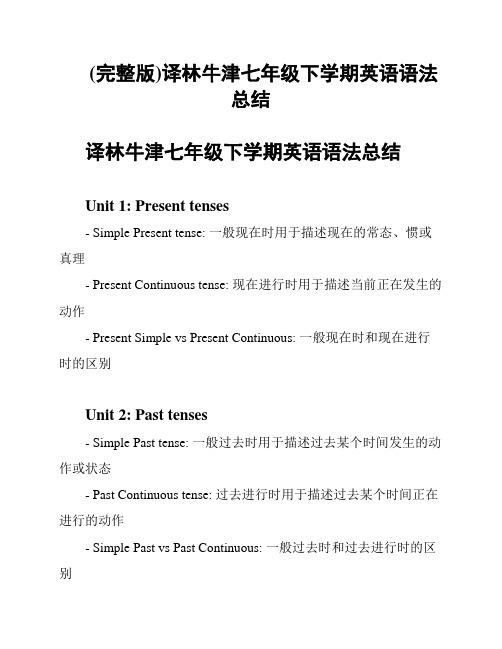
(完整版)译林牛津七年级下学期英语语法总结译林牛津七年级下学期英语语法总结Unit 1: Present tenses- Simple Present tense: 一般现在时用于描述现在的常态、惯或真理- Present Continuous tense: 现在进行时用于描述当前正在发生的动作- Present Simple vs Present Continuous: 一般现在时和现在进行时的区别Unit 2: Past tenses- Simple Past tense: 一般过去时用于描述过去某个时间发生的动作或状态- Past Continuous tense: 过去进行时用于描述过去某个时间正在进行的动作- Simple Past vs Past Continuous: 一般过去时和过去进行时的区别Unit 3: Future tenses- Will + verb: 表示将来的决定、打算或预测- Be going to + verb: 表示计划、意图或预测- Future Continuous tense: 将来进行时用于描述将来某个时间正在进行的动作- Future Simple vs Be going to: 将来时的两种表达方式的区别Unit 4: Passive voice- Active voice vs Passive voice: 主动语态和被动语态的区别- How to form the passive voice: 构成被动语态的方法- Passive voice with different tenses: 不同时态的被动语态形式Unit 5: Modal verbs- Can, could, may, might: 表示能力、允许或可能性- Must, have to: 表示必须、责任或推测- Should, ought to: 表示应该、建议或期望Unit 6: Conditionals- Zero conditional: 表示真理、自然法则或普遍情况- First conditional: 表示可能性、条件或可能的反应- Second conditional: 表示假设、不太可能的情况或对应的行动- Third conditional: 表示虚构、过去的假设或悔恨Unit 7: Reported speech- Reporting verbs: 常用的引述动词- Reporting statements: 直接引述陈述句的变化- Reporting questions: 直接引述疑问句的变化以上是译林牛津七年级下学期英语语法总结的内容。
牛津译林版英语初二上册语法规则总结
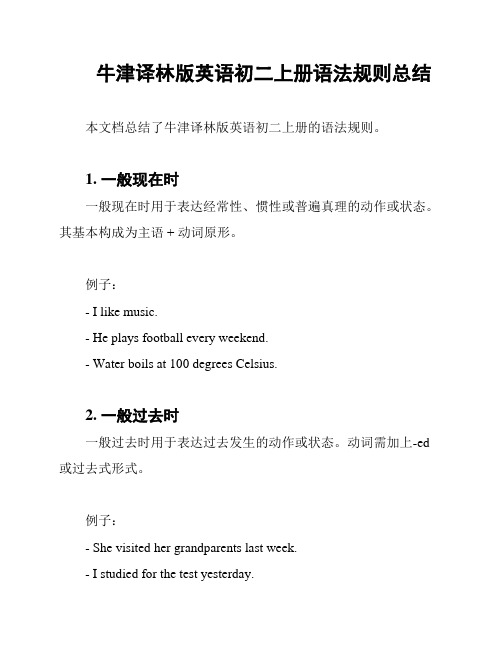
牛津译林版英语初二上册语法规则总结本文档总结了牛津译林版英语初二上册的语法规则。
1. 一般现在时一般现在时用于表达经常性、惯性或普遍真理的动作或状态。
其基本构成为主语 + 动词原形。
例子:- I like music.- He plays football every weekend.- Water boils at 100 degrees Celsius.2. 一般过去时一般过去时用于表达过去发生的动作或状态。
动词需加上-ed 或过去式形式。
例子:- She visited her grandparents last week.- I studied for the test yesterday.- They played basketball for two hours.3. 现在进行时现在进行时用于表达目前正在进行的动作。
其构成为主语 + am/is/are + 动词-ing形式。
例子:- We are watching a movie right now.- The baby is sleeping.4. 一般将来时一般将来时用于表达将来某个时间会发生的动作。
其构成为主语 + will + 动词原形。
例子:- We will go shopping tomorrow.- She will call you later.- They will visit their relatives next month.5. 一般过去将来时一般过去将来时用于过去将来某个时间会发生的动作。
其构成为主语 + was/were going to + 动词原形。
例子:- He said he was going to visit his parents yesterday.- I thought we were going to have a meeting last night.6. 祈使句祈使句用于表示命令、请求或建议。
译林牛津七年级上学期英语语法知识总结

译林牛津七年级上学期英语语法知识总结本文档总结了译林牛津七年级上学期英语语法知识,旨在帮助学生复和巩固所学内容。
1. 词性分类- 名词(Noun):指示物或概念的名称,如人、地方、物品等。
- 动词(Verb):表示动作或状态的词语。
- 形容词(Adjective):用于描述名词的特征或性质。
- 副词(Adverb):用于修饰动词、形容词或其他副词,表示程度、方式或时间等。
- 介词(Preposition):用于表示方位、时间、方式等关系的词语。
- 代词(Pronoun):用于替代名词的词语,可以指代人或事物。
- 冠词(Article):表示名词特指或泛指的词语,包括定冠词(the)和不定冠词(a/an)。
- 连词(Conjunction):连接词与词、短语与短语、从句与从句等的词语。
2. 句子结构- 主语(Subject):句子中进行动作或被描述的人、事物或概念。
- 谓语(Predicate):句子中表达动作或状态的部分,通常是动词。
- 宾语(Object):动作的承受者或受益者,是动词的补充部分。
- 定语(Attributive):用于修饰名词或代词的形容词、副词等。
- 状语(Adverbial):修饰动词或整个句子的副词、介词短语等。
3. 时态与语态- 时态(Tense):表示动作发生的时间,如一般现在时、过去时、将来时等。
- 语态(Voice):表示动作的主体和动作所受的影响关系,如主动语态和被动语态。
4. 句型结构- 简单句(Simple Sentence):只包含一个主语和一个谓语的句子。
- 并列句(Coordination Sentence):由并列连词连接的两个或多个简单句。
- 疑问句(Question Sentence):用于提问的句子,通常以疑问词开头或动词倒装。
以上是关于译林牛津七年级上学期英语语法知识的简要总结。
希望这份文档能够帮助你更好地复习和应用所学的语法知识。
祝你学习进步!。
牛津译林七年级语法总结
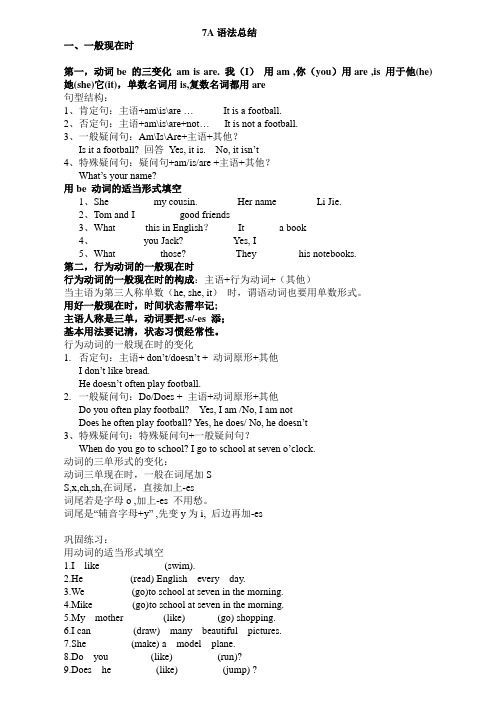
7A语法总结一、一般现在时第一,动词be 的三变化am is are. 我(I)用am ,你(you)用are ,is 用于他(he)她(she)它(it),单数名词用is,复数名词都用are句型结构:1、肯定句:主语+am\is\are … It is a football.2、否定句:主语+am\is\are+not… It is not a football.3、一般疑问句:Am\Is\Are+主语+其他?Is it a football? 回答Yes, it is. No, it isn’t4、特殊疑问句:疑问句+am/is/are +主语+其他?What’s your name?用be 动词的适当形式填空1、She ________ my cousin. Her name _______ Li Jie.2、Tom and I ________ good friends3、What _____ this in English?It ______ a book4、________ you Jack? Yes, I _______5、What ________ those? They ______ his notebooks.第二,行为动词的一般现在时行为动词的一般现在时的构成:主语+行为动词+(其他)当主语为第三人称单数(he, she, it)时,谓语动词也要用单数形式。
用好一般现在时,时间状态需牢记;主语人称是三单,动词要把-s/-es 添;基本用法要记清,状态习惯经常性。
行为动词的一般现在时的变化1.否定句:主语+ don’t/doesn’t + 动词原形+其他I don’t like bread.He doesn’t often play football.2.一般疑问句:Do/Does + 主语+动词原形+其他Do you often play football? Yes, I am /No, I am notDoes he often play football? Yes, he does/ No, he doesn’t3、特殊疑问句:特殊疑问句+一般疑问句?When do you go to school? I go to school at seven o’clock.动词的三单形式的变化:动词三单现在时,一般在词尾加SS,x,ch,sh,在词尾,直接加上-es词尾若是字母o ,加上-es 不用愁。
译林牛津七年级上学期英语语法规则总结

译林牛津七年级上学期英语语法规则总结本文档总结了译林牛津七年级上学期英语的语法规则。
1. 名词名词是表示人、动物、事物、地点等具体或抽象概念的词语。
名词在句子中可以作为主语、宾语、定语等。
1.1 单数名词- 单数名词一般直接使用,例如:book(书)、apple(苹果)。
1.2 复数名词- 复数名词一般在词尾加上-s或-es,例如:books(书籍)、apples(苹果)。
2. 动词动词表示动作或状态的词语。
动词在句子中可以作为谓语、宾语、定语等。
2.1 一般现在时- 一般现在时用于表示经常性或普遍性的行为或状态,例如:I go to school every day(我每天去学校)。
2.2 动词原形- 动词原形用于表示对某事物的普遍性描述,例如:Water boils at 100 degrees Celsius(水在100摄氏度烧开)。
3. 形容词形容词用于修饰名词或代词,表示人或事物的性质或特征。
3.1 形容词的比较级- 形容词的比较级用于比较两个人或事物的差异,例如:She is taller than me(她比我高)。
3.2 形容词的最高级- 形容词的最高级用于比较三个或更多人或事物的差异,例如:He is the tallest boy in the class(他是班级里最高的男孩)。
4. 副词副词用于修饰动词、形容词或其他副词,表示时间、地点、方式、程度等。
4.1 副词的用法- 副词可以修饰动词、形容词或其他副词,例如:She runs quickly(她跑得快)。
5. 介词介词用于表示人或事物在时间、地点、方式等方面的关系。
5.1 常见介词- 常见的介词有in(在)、on(在上面)、at(在...处)等,例如:He is studying in the library(他在图书馆研究)。
6. 冠词冠词用于限定名词。
6.1 定冠词- 定冠词用于表示特定的、已知的人或事物,例如:The book on the table is mine(桌子上的那本书是我的)。
苏教版译林牛津重点初中英语语法总结归纳(初一初二
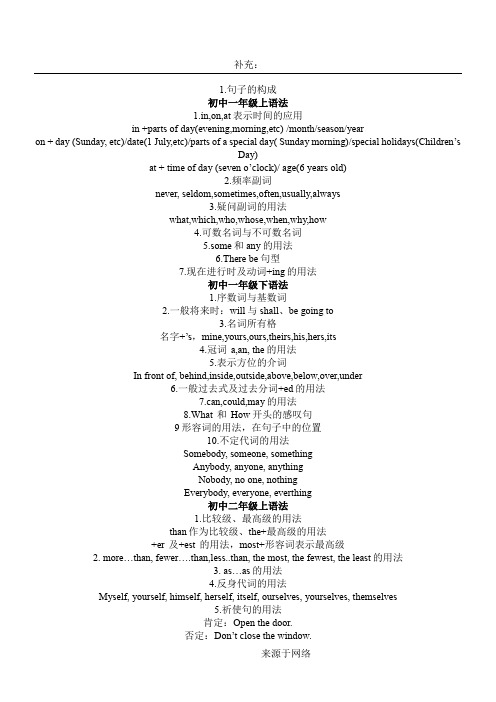
补充:1.句子的构成初中一年级上语法1.in,on,at表示时间的应用in +parts of day(evening,morning,etc) /month/season/yearon + day (Sunday, etc)/date(1 July,etc)/parts of a special day( Sunday morning)/special holidays(Children’sDay)at + time of day (seven o’clock)/ age(6 years old)2.频率副词1.比较级、最高级的用法than作为比较级、the+最高级的用法+er 及+est 的用法,most+形容词表示最高级2. more…than, fewer….than,less..than, the most, the fewest, the least的用法3. as…as的用法4.反身代词的用法Myself, yourself, himself, herself, itself, ourselves, yourselves, themselves5.祈使句的用法肯定:Open the door.否定:Don’t close the window.礼貌些:Please….6.表示建议should和had better的用法7.may来表示可能性的用法(区别初一下7,may作为询问语气的用法)8.不定式用法9.用不定式表示目的,用in order to表示目的10. A.“动词+宾语+不定式”结构,即,动词+宾语+to do(不定式)可用这类结构的常用动词有?advise, allow, ask, bear, beg, bother, cause, command, determine, encourage, expect, forbid, force, get, hate, help, intend, invite, leave, like, mean, need, order, permit, persuade, prefer, request, remind, request, teach, tell, trouble, want, warn, wish等。
译林版牛津英语七年级下册全册Unites1-8单元知识点及语法归纳

译林版牛津英语七年级下册全册Unites1-8单元知识
点及语法归纳
以下是译林版牛津英语七年级下册全册Unites1-8单元的知识点及语法归纳。
Unit 1 Knowing about yourself 知识点:
1. 询问和介绍自己的姓名、年龄、国籍以及所在地等。
2. 描述自己的外貌特征、爱好和能力。
3. 学习使用形容词、副词、名词、动词等词汇来构造自己的句子。
4. 学会听、说、读、写26个字母。
语法归纳:
1. 人称代词:I, you, he, she, it, we, they.
2. 动词be的各种形式(am, is, are)。
3. 形容词的比较级和最高级形式。
4. 副词和形容词的用法。
5. 一般现在时的肯定句、否定句及一般疑问句。
Unit 2 Disaster zone 知识点:
1. 描述自然灾害的发生和后果。
2. 学习句式\。
七年级上下译林版英语知识点
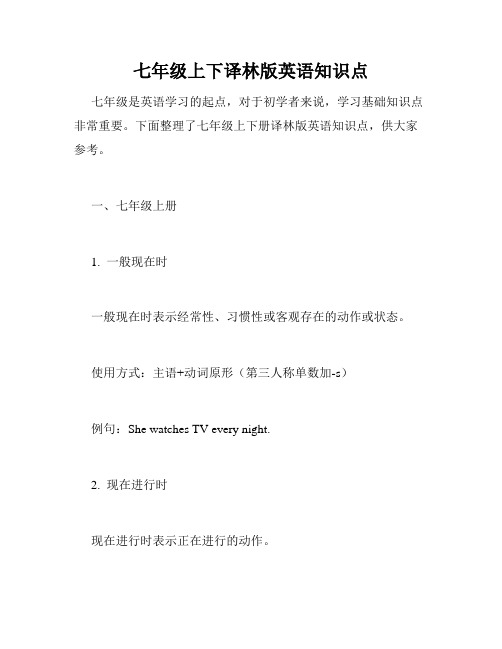
七年级上下译林版英语知识点七年级是英语学习的起点,对于初学者来说,学习基础知识点非常重要。
下面整理了七年级上下册译林版英语知识点,供大家参考。
一、七年级上册1. 一般现在时一般现在时表示经常性、习惯性或客观存在的动作或状态。
使用方式:主语+动词原形(第三人称单数加-s)例句:She watches TV every night.2. 现在进行时现在进行时表示正在进行的动作。
使用方式:主语+be动词(am/is/are)+动词-ing形式例句:I am reading a book now.3. 介词in和on的用法in表示时间、季节、月份、年代等的“在……之中”,on表示天、日期等的“在……之上”。
例句:I was born in 2005.I have English class on Monday.4. 一般过去时一般过去时表示过去某个时间或某个时间段内所发生的事情。
使用方式:主语+动词过去式例句:I played computer games yesterday.5. 数词的读法及口语表达数词的读法及口语表达需熟记,如:1-100的数词、100的整数倍数和小数,以及常用的百分数。
例句:Today is January 1st.I want to buy two bananas.二、七年级下册1. 常见不规则动词的过去式常见不规则动词的过去式需记忆。
如:go-went、eat-ate、drink-drank等。
例句:He ate breakfast at 7 o'clock this morning.2. 一般将来时一般将来时表示将要发生的动作,或表示预计要做的事情。
使用方式:主语+will+动词原形例句:I will visit a friend next Sunday.3. 比较级和最高级比较级和最高级用于比较两个或多个人或事物之间的大小、高低或优劣关系。
使用方式:形容词原级+er(或more)+than…(比较级);形容词最高级+the+形容词最高级+名词例句:My dog is faster than yours.I think math is the most difficult subject.4. 询问地址和路线询问地址和路线需要掌握常用英语词汇和表达,并结合地图进行模拟练习。
苏教版(译林版)初中英语各册单元语法点复习梳理
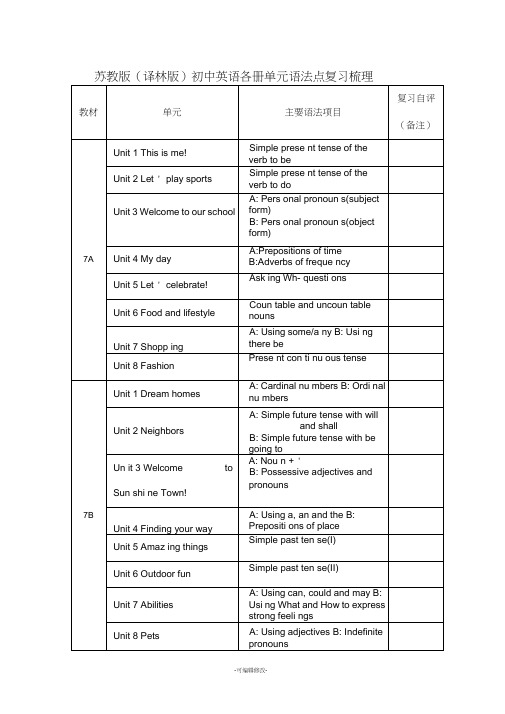
Unit 2 Famous people
Tenses
A: Simple prese nt and prese nt con ti nu ous B: Simple past and past con ti nu ous
Unit 2 Colours
A: Object clauses in troduced by that
B: Object clauses in troduced by if or whether
Unit3Tee nage
problems
A: Object clauses in troduced by questi on words
A: Givi ng reas ons with because
B: Givi ng reas ons with sin cea nd as
Unit 6 TV programmes
A: Using if B: Using uni ess
Unit 7 Films
A: Using although/though B: Using so ... that and such ... that
Unit 8 Pets
A: Using adjectives B: Indefinite pronouns
8A
Unit1Frie nds
Comparative and superlative adjectives
Unit 2 School life
A: Compari ng the amount of things
Unit 3 Welcome to our school
(word完整版)苏教版译林版初中英语各年级知识点,文档
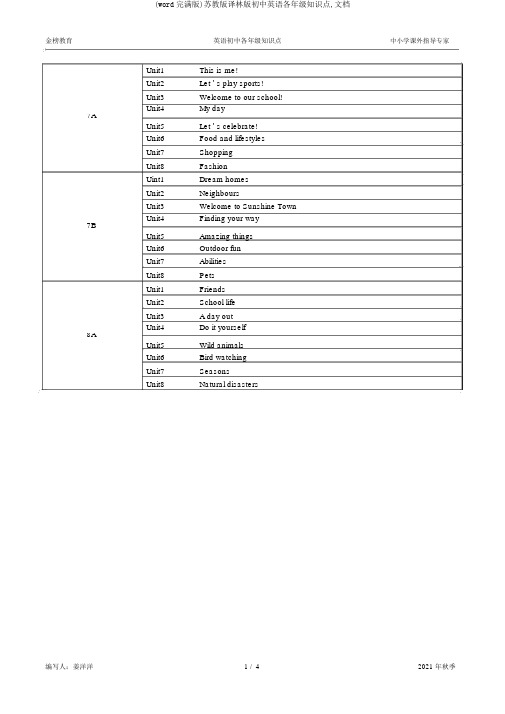
金榜教育英语初中各年级知识点中小学课外指导专家Unit1This is me!Unit2Let ’ s play sports!Unit3Welcome to our school!Unit4My day7AUnit5Let ’ s celebrate!Unit6Food and lifestylesUnit7ShoppingUnit8FashionUint1Dream homesUnit2NeighboursUnit3Welcome to Sunshine TownUnit4Finding your way7BAmazing thingsUnit5Unit6Outdoor funUnit7AbilitiesUnit8PetsUnit1FriendsUnit2School lifeUnit3 A day outUnit4Do it yourself8AUnit5Wild animalsUnit6Bird watchingUnit7SeasonsUnit8Natural disastersUnit1Past and presentUnit2TravellingUnit3Online toursUnit4 A good read8BUnit5Good manners[ 举止高雅 ]Unit6Sunshine for allUnit7International charities[国际慈善机构 ]Unit8 A green worldUnit1Know yourselfUnit2ColoursUnit3Teenage problemsUnit4Growing up9AUnit5Art worldUnit6TV programmesUnit7FilmsUnit8Detective stories[ 侦探小说 ]Unit1AsiaUnit2Great peopleUnit3RobotsUnit4Life on Mars9B1 动词 be 的一般现在时2行为动词的一般现在时3人称代词4表示时间的介词5频度副词7A6特别疑问句7可数名词和不可以数名词8用 some 和 any 表示数量9there be 结构10现在进行时1基数词2序数词3一般将来时〔 will shall 〕4一般将来时〔 be going to 〕5名词所有格6形容词性物主代词和名词性物主代词7冠词 a an the7B8方向介词9一般过去时〔 1〕10一般过去时〔 2〕11神情动词 can could may12What How 感想句13形容词14不定代词1形容词比较级和最高等2数量的比较3副词比较级和最高等4as as的用法5反身代词6祈使句7用 should 和 had better 提建议8神情动词 may 的用法8A9动词不定式作宾语10动词不定式作目的状语11动词不定式作宾语补足语12动词及五种根本句型13连系动词14行为动词15过去进行时16when while 和 as 的用法金榜教育8B9A9B英语初中各年级知识点中小学课外指导专家1现在完成时Ⅰ2现在完成时Ⅱ3现在完成时Ⅲ4疑问词 +动词不定式5must/have to 的用法6enough to 的用法7too to的用法8 It is +adjective(+for-infinitive/of)+to等句型9被动语态的一般现在时和一般过去时10被动语态Ⅱ1并列连词 and、 but 、 or 和 so2并列连词3that 引导的宾语从句4if 或 whether 引导的宾语从句5连接代词和连接副词引导的宾语从句6提建议的句型7while 引导的时间状语从句8until 引导的时间状语从句9as soon as 和 whenever 引导的时间状语从句10Because 引导的原因状语从句11since 和 as 引导的原因状语从句12if 引导的条件状语从句13unless 引导的条件状语从句14although 和 though 引导的退步状语从句15so that和 such that引导的结果状语从句16so that 引导的目的状语从句17限制性定语从句和关系代词1代词 it 的用法2时态3一般现在时和现在进行时4一般过去时和过去进行时5一般过去时和现在完成时6简单句和复合句之间的变换〔一〕7简单句和复合句之间的变换〔二〕。
译林牛津七年级上学期英文语法总结

译林牛津七年级上学期英文语法总结一、Present Simple TensePresent Simple Tense(一般现在时)用于表示经常性的动作、惯、真理或常识。
句子结构为主语 + 动词原形(第三人称单数加-s)。
例如:- I often play basketball after school.- He goes to the gym three times a week.- Water boils at 100 degrees Celsius.二、Past Simple TensePast Simple Tense(一般过去时)用于表示过去发生的动作或存在的状态。
句子结构为主语 + 动词过去式。
例如:- She watched a movie last night.- They visited their grandparents during the summer vacation.- Peter knew the answer to the question.三、Present Continuous TensePresent Continuous Tense(现在进行时)用于表示现在正在进行的动作。
句子结构为主语 + am/is/are + 动词-ing。
例如:- I am studying for the English exam right now.- They are playing soccer in the park.- She is reading a book at the moment.例如:- This book is more interesting than that one.- Tom is taller than his brother.- The red car is faster than the blue one.五、SuperlativesSuperlatives(最高级)用于表示多个事物中最高程度的特征。
最新苏教译林版初中英语语法概要大全精心整理

最新译林版初中英语语法概要【初一七年级上册】Unit1动词be的一般现在时Unit2行为动词的一般现在时Unit3人称代词Unit4表示时间的介词(in/on/at)频度副词Unit5特殊疑问词Unit6可数名词与不可数名词Unit7用some和any表示数量there be 结构Unit8现在进行时【初一七年级下册】Unit1基数词序数词Unit2一般将来时(will/shall)一般将来时(be going to)Unit3名词所有格形容词性物主代词和名词性物主代词Unit4冠词a/an/the方位介词Unit5一般过去时(1)Unit6一般过去时(2)Unit7情态动词can/could/mayWhat/How感叹句Unit8形容词不定代词【初二八年级上册】Unit1形容词比较级和最高级Unit2数量的比较副词比较级和最高级Unit3as...as的用法反身代词Unit4祈使句用should和had better提建议Unit5情态动词may的用法动词不定时作宾语Unit6动词不定时作目的状语动词不定时作宾语补足语Unit7动词及五种基本句型Unit8过去进行时when,while和as的用法【初二八年级下册】Unit1现在完成时(1)Unit2现在完成时(2)Unit3现在完成时(3)Unit4疑问词+动词不定式must和have to的用法Unit5enough to的用法too...to的用法Unit6It is +adj(for.../of)+to infinitive句型Unit7被动语态(1)被动语态的一般现在时和一般过去时Unit8被动语态(2)被动语态的一般将来时被动语态(2)。
(完整word版)苏教版译林牛津初中英语语法总结(初一初二),推荐文档.doc

补充:1.句子的构成初中一年级上语法1.in,on,at 表示时间的应用in +parts of day(evening,morning,etc) /month/season/yearon + day (Sunday, etc)/date(1 July,etc)/parts of a special day( Sunday morning)/special holidays(Children ’s Day)at + time of day (seven o ’clock)/ age(6 years old)2.频率副词never, seldom,sometimes,often,usually,always3.疑问副词的用法what,which,who,whose,when,why,how4.可数名词与不可数名词5.some 和 any 的用法6.There be 句型7.现在进行时及动词+ing 的用法初中一年级下语法1.序数词与基数词2.一般将来时: will 与 shall、 be going to3.名词所有格名字 +’s, mine,yours,ours,theirs,his,hers,its4.冠词a,an, the 的用法5.表示方位的介词In front of, behind,inside,outside,above,below,over,under6.一般过去式及过去分词+ed 的用法7.can,could,may 的用法8.What 和 How 开头的感叹句9形容词的用法,在句子中的位置10.不定代词的用法Somebody, someone, somethingAnybody, anyone, anythingNobody, no one, nothingEverybody, everyone, everthing初中二年级上语法1.比较级、最高级的用法than 作为比较级、the+最高级的用法+er 及 +est 的用法, most+ 形容词表示最高级2. more than, fewer .than,less..than, the most, the fewest, the least的用法3. as as 的用法4.反身代词的用法Myself, yourself, himself, herself, itself, ourselves, yourselves, themselves5.祈使句的用法肯定: Open the door.否定: Don’tclose the window.礼貌些: Please .6.表示建议should 和 had better 的用法7.may 来表示可能性的用法(区别初一下7,may 作为询问语气的用法)8.不定式用法9.用不定式表示目的,用in order to 表示目的10. A.“动词 +宾语 +不定式”结构,即,动词+宾语 +to do (不定式)可用这类结构的常用动词有advise, allow, ask, bear, beg, bother, cause, command, determine, encourage, expect, forbid, force, get, hate, help, intend, invite, leave, like, mean, need, order, permit, persuade, prefer, request, remind, request, teach, tell, trouble, want, warn, wish等。
译林版牛津英语七年级下册全册Unites1_8单元知识点与语法归纳

七年级英语下册知识点总结Unit 1 Dream homes一、重点词组、句型1、Would you like to live in the palace, Eddie? 埃迪,你想住宫殿里吗?①Would you like sth? 肯定回答:Yes, please. 否定回答:No, thanks.②Would you like to do sth? 肯定回答:Yes, I’d like/love to. 否定回答:I’d like/love to, but…2、There are twenty restaurants in town. 镇上有二十家餐馆。
There are about 8,000,000 people living in London. 大约有八百万人住在伦敦。
①表示某地有……,用there be 句型,谓语动词就近原则。
There __________(be) an art room, a music room and two computer rooms in our school.②表示有事情要做,用there be sth to do。
There are lots of things ___________(see) in Beijing..③表示有某人正在做某事,用there be sb doing sth.。
On game shows, there are always famous people___________(talk) about their lives.3、I live in a town 15 miles from London. 我住在离伦敦15英里的一个镇上。
be far (away) from 离……远,但出现具体距离时,不用farMy home is __________________from the school.My home is 5 kilometres ___________from the school. A. away B. far C. close D. next to 4. have fun with sb./sth. 和某人/某物玩得开心have fun doing sth. 做某事很开心have(has/had) fun= have(has/had) a good time= enjoy(enjoyed) onself(myself/yourself/youselves……)5、I also have a bedroom of my own. =I also have my own bedroom. 我也有自己的房间。
译林版牛津英语七年级下册全册Unites1-8单元知识点及语法归纳
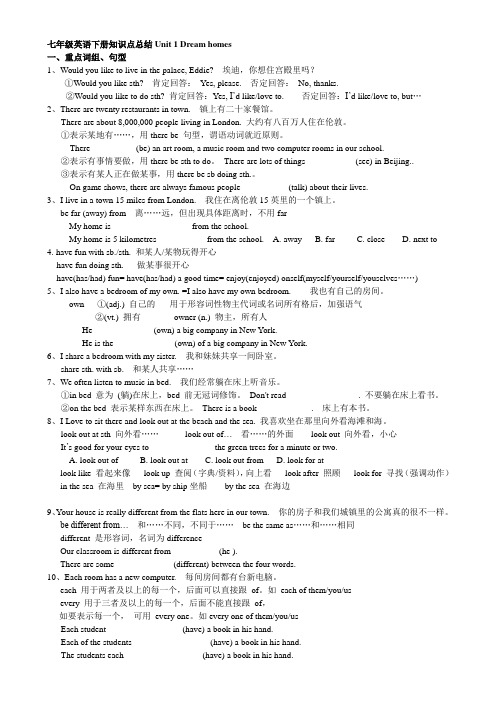
七年级英语下册知识点总结Unit 1 Dream homes一、重点词组、句型1、Would you like to live in the palace, Eddie? 埃迪,你想住宫殿里吗?①Would you like sth? 肯定回答:Yes, please. 否定回答:No, thanks.②Would you like to do sth? 肯定回答:Yes, I’d like/love to. 否定回答:I’d like/love to, but…2、There are twenty restaurants in town. 镇上有二十家餐馆。
There are about 8,000,000 people living in London. 大约有八百万人住在伦敦。
①表示某地有……,用there be 句型,谓语动词就近原则。
There __________(be) an art room, a music room and two computer rooms in our school.②表示有事情要做,用there be sth to do。
There are lots of things ___________(see) in Beijing..③表示有某人正在做某事,用there be sb doing sth.。
On game shows, there are always famous people___________(talk) about their lives.3、I live in a town 15 miles from London. 我住在离伦敦15英里的一个镇上。
be far (away) from 离……远,但出现具体距离时,不用farMy home is __________________from the school.My home is 5 kilometres ___________from the school. A. away B. far C. close D. next to 4. have fun with sb./sth. 和某人/某物玩得开心have fun doing sth. 做某事很开心have(has/had) fun= have(has/had) a good time= enjoy(enjoyed) onself(myself/yourself/youselves……)5、I also have a bedroom of my own. =I also have my own bedroom. 我也有自己的房间。
译林版牛津英语七年级下册全册Unites1-8单元知识点及语法归纳

译林版牛津英语七年级下册全册Unites1-8单元知识点及语法归纳一、重点词组、句型1、Would you like to live in the palace, Eddie? 埃迪,你想住宫殿里吗?①Would you like sth? 肯定答复: Yes, please. 否认答复: No, thanks.②Would you like to do sth? 肯定答复:Yes, I’d like/love to. 否认答复:I’d like/love to, but…2、There are twenty restaurants in town. 镇上有二十家餐馆。
There are about 8,000,000 people living in London. 大约有八百万人住在伦敦。
①表示某地有……,用there be 句型,谓语动词就近原那么。
There __________(be) an art room, a music room and two puter rooms in our school.②表示有事情要做,用there be sth to do。
Thereare lots of things ___________(see) in Beijing..③表示有某人正在做某事,用there be sb doingsth.。
On game shows, there are always famouspeople___________(talk) about their lives.3、I live in a town 15 miles from London. 我住在离伦敦15英里的一个镇上。
be far (away) from 离……远,但出现详细间隔时,不用farMy home is __________________from the school.My home is 5 kilometres ___________from the school.A. awayB. farC. closeD. next to4. have fun with sb./sth. 和某人/某物玩得开心have fun doing sth. 做某事很开心have(has/had) fun= have(has/had) a good time=enjo y(enjoyed) onself(myself/yourself/youselves……)5、I also have a bedroom of my own. =I also havemy own bedroom. 我也有自己的房间。
苏教版译林牛津重点初中英语语法总结(初一初二)(K12教育文档)
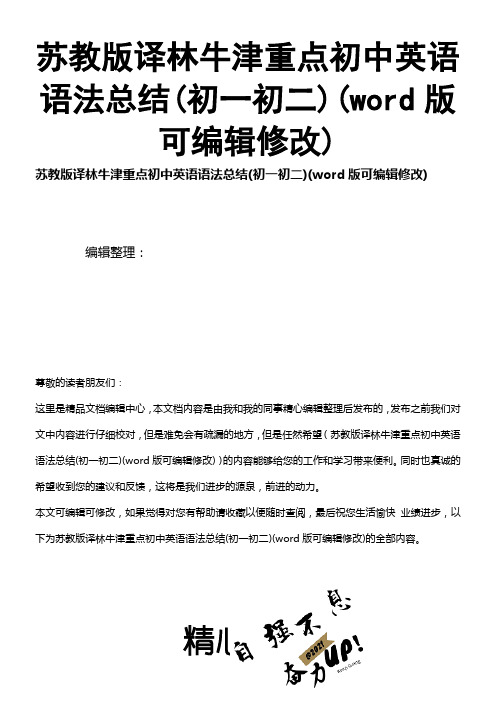
语法总结(初一初二)(word版可编辑修改)苏教版译林牛津重点初中英语语法总结(初一初二)(word版可编辑修改) 编辑整理:尊敬的读者朋友们:这里是精品文档编辑中心,本文档内容是由我和我的同事精心编辑整理后发布的,发布之前我们对文中内容进行仔细校对,但是难免会有疏漏的地方,但是任然希望(苏教版译林牛津重点初中英语语法总结(初一初二)(word版可编辑修改))的内容能够给您的工作和学习带来便利。
同时也真诚的希望收到您的建议和反馈,这将是我们进步的源泉,前进的动力。
本文可编辑可修改,如果觉得对您有帮助请收藏以便随时查阅,最后祝您生活愉快业绩进步,以下为苏教版译林牛津重点初中英语语法总结(初一初二)(word版可编辑修改)的全部内容。
精心整理语法总结(初一初二)(word版可编辑修改)补充:1.句子的构成初中一年级上语法1。
in,on,at表示时间的应用in +parts of day(evening,morning,etc)/month/season/year精心整理语法总结(初一初二)(word版可编辑修改)on + day (Sunday, etc)/date(1 July,etc)/parts of a special day( Sunday morning)/special holidays(Children's Day)at + time of day (seven o’clock)/ age(6 yearsold)精心整理语法总结(初一初二)(word版可编辑修改)2。
频率副词never,seldom,sometimes,often,usually,always3。
疑问副词的用法what,which,who,whose,when,why,how 4。
可数名词与不可数名词精心整理语法总结(初一初二)(word版可编辑修改)5.some和any的用法6.There be句型7。
现在进行时及动词+ing的用法初中一年级下语法1。
苏教版译林牛津初中英语语法总结(初一初二)

苏教版译林牛津初中英语语法总结(初一初二)补充:1.句子的构成初中一年级上语法1.in,on,at表示时间的应用in +parts of day(evening,morning,etc) /month/season/year on + day (Sunday, etc)/date(1 July,etc)/parts of a special day( Sunday morning)/special holidays(Children’s Day) at + time of day (seven o’clock)/ age(6 years old)2.频率副词never, seldom,sometimes,often,usually,always3.疑问副词的用法what,which,who,whose,when,why,how4.可数名词与不可数名词5.some和any的用法6.There be句型7.现在进行时及动词+ing的用法初中一年级下语法1.序数词与基数词2.一般将来时:will与shall、be going to3.名词所有格名字+’s,mine,yours,ours,theirs,his,hers,its4.冠词a,an, the的用法5.表示方位的介词In front of, behind,inside,outside,above,below,over,under6.一般过去式及过去分词+ed的用法7.can,could,may的用法8.What 和How开头的感叹句9形容词的用法,在句子中的位置10.不定代词的用法Somebody, someone, somethingAnybody, anyone, anythingNobody, no one, nothingEverybody, everyone, everthing初中二年级上语法1.比较级、最高级的用法than作为比较级、the+最高级的用法+er 及+est 的用法,most+形容词表示最高级2. more…than, fewer….than,less..than, the most, the fewest, the least的用法3. as…as的用法4.反身代词的用法Myself, yourself, himself, herself, itself, ourselves, yourselves, themselves5.祈使句的用法肯定:Open the door.否定:Don’t close the window.礼貌些:Please….6.表示建议should和had better的用法7.may来表示可能性的用法(区别初一下7,may作为询问语气的用法)8.不定式用法9.用不定式表示目的,用in order to表示目的10. A.“动词+宾语+不定式”结构,即,动词+宾语+to do(不定式)可用这类结构的常用动词有advise, allow, ask, bear, beg, bother, cause, command, determine, encourage, expect, forbid, force, get, hate, help, intend, invite, leave, like, mean, need, order, permit, persuade, prefer, request, remind, request, teach, tell,trouble, want, warn, wish等。
- 1、下载文档前请自行甄别文档内容的完整性,平台不提供额外的编辑、内容补充、找答案等附加服务。
- 2、"仅部分预览"的文档,不可在线预览部分如存在完整性等问题,可反馈申请退款(可完整预览的文档不适用该条件!)。
- 3、如文档侵犯您的权益,请联系客服反馈,我们会尽快为您处理(人工客服工作时间:9:00-18:30)。
苏教版译林牛津初中英语语法总结初一初二
集团文件发布号:(9816-UATWW-MWUB-WUNN-INNUL-DQQTY-
补充:
1.句子的构成
初中一年级上语法
1.in,on,at表示时间的应用
in +parts of day(evening,morning,etc) /month/season/year
on + day (Sunday, etc)/date(1 July,etc)/parts of a special day( Sunday morning)/special holidays(Children’s Day)
at + time of day (seven o’clock)/ age(6 years old)
2.频率副词
never, seldom,sometimes,often,usually,always
3.疑问副词的用法
what,which,who,whose,when,why,how
4.可数名词与不可数名词
5.some和any的用法
6.There be句型
7.现在进行时及动词+ing的用法
初中一年级下语法
1.序数词与基数词
2.一般将来时:will与shall、be going to
3.名词所有格
名字+’s,mine,yours,ours,theirs,his,hers,its
4.冠词 a,an, the的用法
5.表示方位的介词
In front of, behind,inside,outside,above,below,over,under
6.一般过去式及过去分词+ed的用法
7.can,could,may的用法
8.What 和 How开头的感叹句
9形容词的用法,在句子中的位置
10.不定代词的用法
Somebody, someone, something
Anybody, anyone, anything
Nobody, no one, nothing
Everybody, everyone, everthing
初中二年级上语法
1.比较级、最高级的用法
than作为比较级、the+最高级的用法
+er 及+est 的用法,most+形容词表示最高级
2. more…than, fewer….than,less..than, the most, the fewest, the least的用法
3. as…as的用法
4.反身代词的用法
Myself, yourself, himself, herself, itself, ourselves, yourselves, themselves
5.祈使句的用法
肯定:Open the door.
否定:Don’t close the window.
礼貌些:Please….
6.表示建议 should和had better的用法
7.may来表示可能性的用法(区别初一下7,may作为询问语气的用法)
8.不定式用法
9.用不定式表示目的,用 in order to表示目的
10. A.“动词+宾语+不定式”结构,即,动词+宾语+to do(不定式)
可用这类结构的常用动词有?advise, allow, ask, bear, beg, bother, cause, command, determine, encourage, expect, forbid, force, get, hate, help, intend, invite, leave, like, mean, need, order, permit, persuade, prefer, request, remind, request, teach, tell, trouble, want, warn, wish等。
B.不需要加to的动词:
使役动词:make, let等
感官动词:see, hear等
(关于各种动词的用法,后续有专题讲解)
11.句型:
主语+谓语
主语+谓语+宾语
主语+谓语+表语
主语+谓语+间接宾语+直接宾语
主语+谓语+直接宾语+间接宾语
12.过去进行时
13.when, while, as的用法及区别
初中二年级下语法
1.现在完成时 Unit1
2.have /has been与have /has gone 区别 Unit2
3. 一般过去时,过去完成时 Unit3
4.疑问词+不定式 Unit4
What to…
Who to…
When to…
Where to…
Which to…
How to…
5.Be enough to:
to be+adj.+enough+不定式
Too...to:
To be + too +adj.+不定式 unit5
6. It is+adj.+for+不定式 Unit6
It is+adj+of+不定式
7.被动语态及其在一般现在时和一般过去时中的应用 Unit7
8.被动语态在一般将来时中的应用 Unit8。
